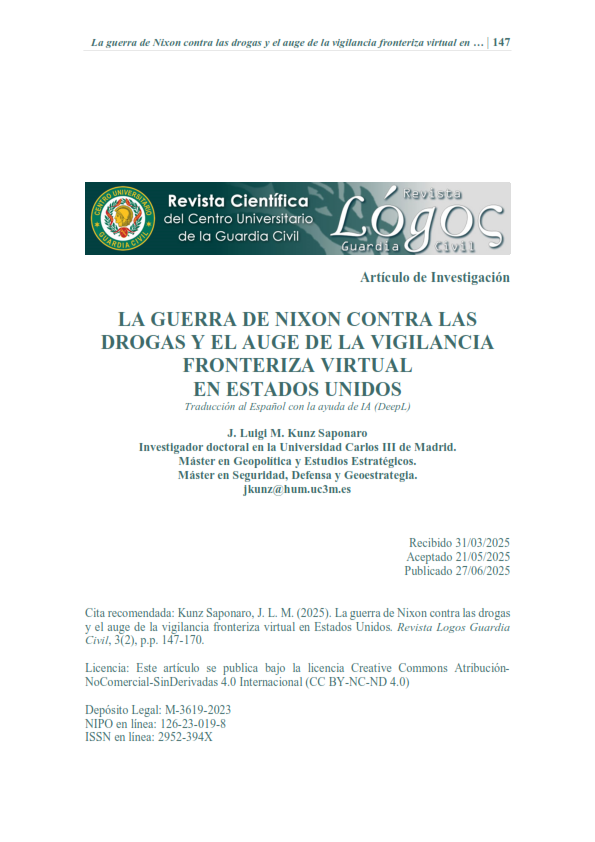Nixon’s War on Drugs and the Rise of Virtual Border Enforcement in the United States
Keywords:
US–Mexico Border, Digital Surveillance, Securitisation Theory, War on Drugs, Nixon AdministrationAbstract
This paper investigates the evolution of the United States–Mexico border from a historically symbolic boundary into one of the most fortified and technologically advanced frontiers in the world. Initial symbolic physical demarcations placed along the border, served to formalise the division between the two nations. However, recent decades have witnessed a significant transformation in border enforcement practices, characterised by the integration of digital surveillance mechanisms that strengthen traditional physical barriers. This study addresses this phenomenon by exploring the nexus between Nixon’s War on Drugs and the digitalisation of the US–Mexico border during the Nixon Administration (1969–1974). By conceptualising the drug crisis as an existential threat, President Nixon’s rhetoric framed these substances as the “enemy number one” starting his War on Drugs. This shaped a securitisation process that enabled the allocation of extraordinary resources to counter this new perceived menace. By employing the securitisation theory developed by the Copenhagen School, this paper analyses the role played by Nixon in framing the security threat to elucidate how this discourse justified the creation of virtual border control practices in the United States. The findings suggest that the securitisation of the drug crisis provided the necessary political and ideological foundation for adopting innovative digital surveillance technologies, a process that has since transformed border enforcement practices. This inquiry contributes to the academic debate on border digitalisation and offers a methodological framework for comparative studies on the virtual evolution of national boundaries.
Downloads
References
Adams, J. (2001). Virtual Defense. Foreign Affairs, 80(3), 98–112.
Amoore, L., Marmura, S., & Salter, M. B. (2008). Smart borders and mobilities: Spaces, zones, enclosures. Surveillance & Society, 5(2).
Armstrong, W. G. (1992). Punishment, Surveillance, and Discipline in Paradise Lost. Studies in English Literature, 1500-1900, 32(1), 91–109. https://doi.org/10.2307/450942
Barkan, R. (1972, February 18). They are watching you, through walls, in the dark of night while you walk around, and it comes from vietnam. Free Press.
Dafoe, A. (2015). On Technological Determinism: A Typology, Scope Conditions, and a Mechanism. Science, Technology, & Human Values, 40(6), 1047–1076. http://www.jstor.org/stable/43671266
Ghaffary, S. (2019, May 16). The “smarter” Wall: How drones, sensors, and ai are patrolling the border. Vox.
Grandin, G. (2019, February 9). How the U.S. weaponized the Border Wall. The Intercept.
Grillo, I. (2013). Mexican Cartels: A Century of Defying U.S. Drug Policy. The Brown Journal of World Affairs, 20(1), 253–265. http://www.jstor.org/stable/24590897
Heyman, J. McC. (2008). Constructing a Virtual Wall: Race and Citizenship in U.S.-Mexico Border Policing. Journal of the Southwest, 50(3), 305–333.
Kerr, D. (1999). Beheading the King and Enthroning the Market: A Critique of Foucauldian Governmentality. Science & Society, 63(2), 173–202.
Koslowski, R. K. (2019, May 29). Immigration reforms and border security technologies. Items. https://items.ssrc.org/border-battles/immigration-reforms -and-border-security-technologies/
Lee, J. (2005, August 31). James H. Scheuer, 13-term New York congressman, is dead at 85. The New York Times.
Lemke, T. (2015). Foucault, governmentality, and critique. Routledge.
Lopez, G. (2016, March 22). Nixon official: Real reason for the drug war was to criminalize black people and hippies. Vox. https://www.vox.com/2016/3/22/11278760/war-on- drugs-racism-nixon
Lynch, M. (2008). Ideas and Perspectives. In The Handbook of Socience and Technology Studies edited by Hackett, E. J., Amsterdamska, O., and Wajcman, J., 9-11. Cambridge, MA: MIT Press
Mendoza, M. E. (2023, October 30). The history of the U.S.-Mexico Border Wall. Time. https://time.com/6324599/bidens-trump-history-border-wall/
Nail, T. (2016). Theory of the Border. Oxford University Press.
Novak, M. (2015, September 24). How the Vietnam War brought high-tech border surveillance to America. Gizmodo.
Otukoya, T. A. (2024). The securitization theory. International Journal of Science and Research Archive, 11(1), 1747–1755. https://doi.org/10.30574/ijsra.2024.11.1.0225
Paden, R. (1984). Surveillance and Torture: Foucault and Orwell on the Methods of Discipline. Social Theory and Practice, 10(3), 261–271.
Reid, Justin M. "'An Exercise in International Extortion': Operation 'Intercept' and Nixon’s 1969 War on Drugs." Master's thesis, Chapman University, 2022. https://doi.org/10.36837/chapman.000412
Sharma, V. (2023). A review of Thomas Nail's 'Theory of the border.'. New Zealand Journal of Asian Studies.
Smith, M. R., & Marx, L. (Eds.). (1994). Does technology drive history?: The dilemma of technological determinism. Mit Press.
Timmons, P. (2017). Trump’s Wall at Nixon’s Border: How Richard Nixon’s Operation Intercept laid the foundation for decades of U.S.-Mexico border policy, including Donald Trump’s wall. NACLA Report on the Americas, 49(1), 15–24. https://doi.org/10.1080/10714839.2017.1298238
Toshkov, D. (2016). Research Design in Political Science. Basingstoke: Palgrave Macmillan.
Trist, N., Cuevas, L., Couto, B., & Atristain, M. (2022). The Treaty of Guadalupe Hidalgo. In G. M. Joseph & T. J. Henderson (Eds.), The Mexico Reader: History, Culture, Politics (pp. 599–603). Duke University Press. https://doi.org/10.2307/j.ctv2rr3g8m.96
US Customs and Border Protection. (2019). Did you know... Century-old obelisks Mark U.S.-Mexico Boundary Line?. U.S. Customs and Border Protection. https://www.cbp.gov/about/history/did-you-know/obelisk
US Deparment of Defense (2017). 41 Nixon Remarks Intensified Program for Drug Abuse. US Government.
Vulliamy, E. (2011, July 23). Nixon’s “War on Drugs” began 40 years ago, and the battle is still raging. The Guardian. https://www.theguardian.com/society/2011/jul/24/war-on-drugs-40-years
Wæver, O. (1995). Securitization and Desecuritization. In R. D. Lipschutz (Ed.), On Security (pp. 46-87). Columbia University Press.

Downloads
Published
How to Cite
Issue
Section
License
Copyright (c) 2025 J. Luigi M. Kunz Saponaro

This work is licensed under a Creative Commons Attribution-NonCommercial-NoDerivatives 4.0 International License.
-
Attribution — You must give appropriate credit, provide a link to the license, and indicate if changes were made. You may do so in any reasonable manner, but not in any way that suggests the licensor endorses you or your use.
-
NonCommercial — You may not use the material for commercial purposes.
-
NoDerivatives — If you remix, transform, or build upon the material, you may not distribute the modified material.
- No additional restrictions — You may not apply legal terms or technological measures that legally restrict others from doing anything the license permits.



